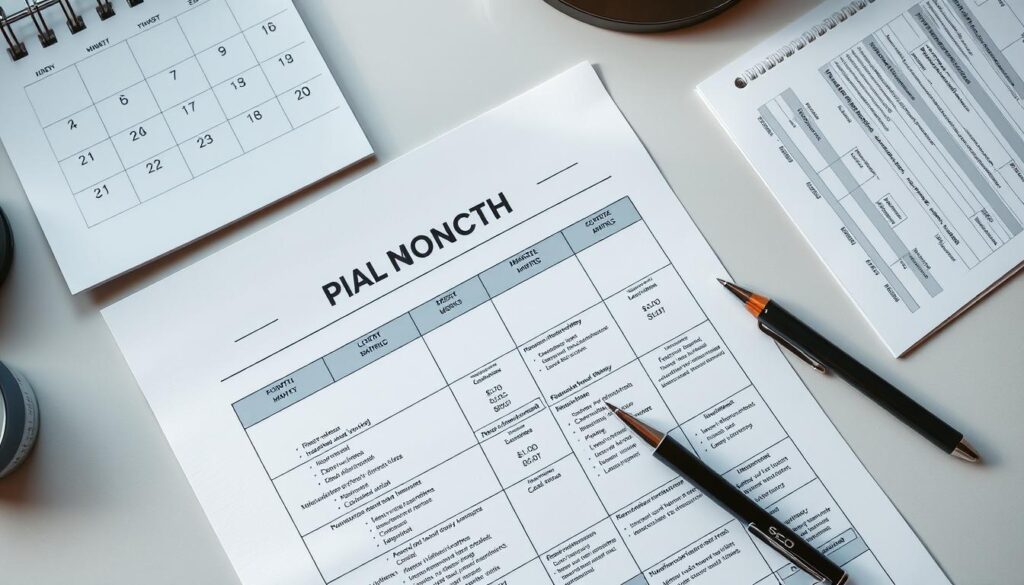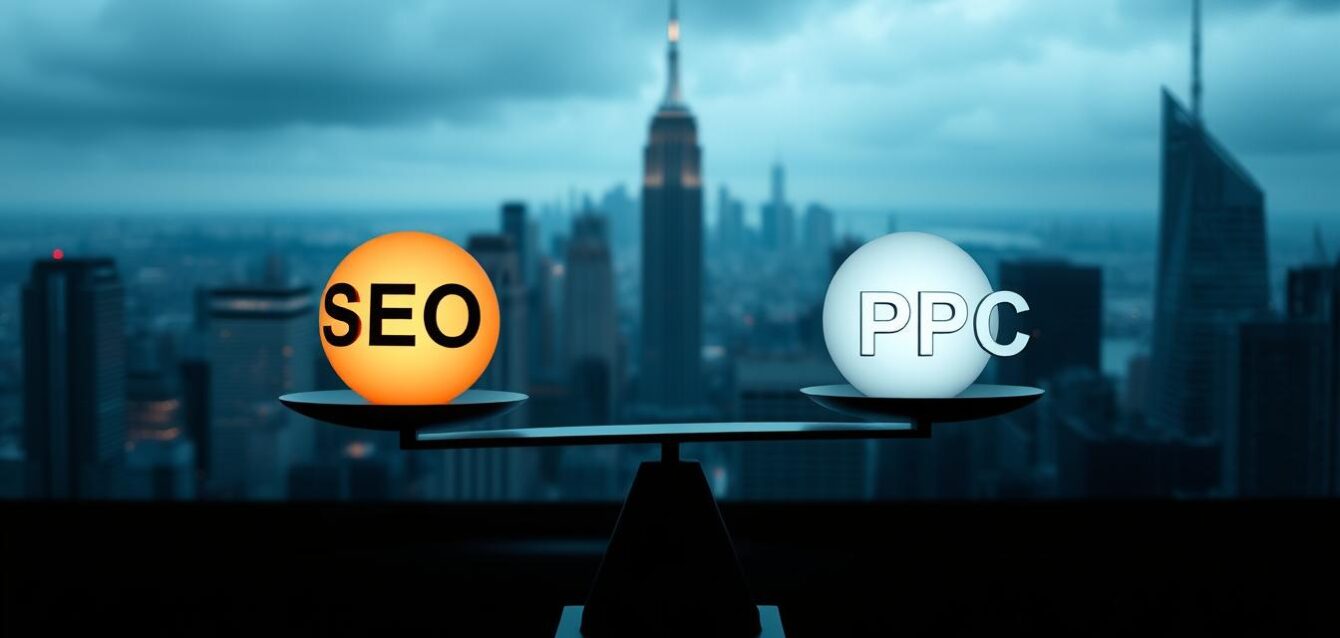During this recession, cost-per-click has surged and many teams face hiring freezes—so one misstep can cost months of growth. We cut through noise with a practical, data-backed framework. We show when to spend for immediate visibility and when to invest for compounding rewards.
PPC buys speed: expect a 30–60 day ramp and measurable volume within weeks. Organic work compounds: expect 6–12 months to see durable gains that keep delivering after spend slows.
We weigh urgency against long-term equity, cash runway against future brand strength. Our approach models CPC, CPA, CVR, and LTV by channel. Then we set ceilings and payback triggers to protect conversion outcomes.
What you’ll get: a six-month plan, KPI map, and clear reallocation rules so leaders can act with authority—not react to noise. We partner with high-ticket brands to engineer growth using proven playbooks and the Macro Webber Growth Blueprint.
Key Takeaways
- Rise in CPCs demands precise spend that defends every dollar for measurable results.
- PPC delivers fast volume; organic channels build lasting conversion leverage.
- Model time-to-return and set payback thresholds before shifting weight between channels.
- Agree on timelines and metrics up front to avoid reactive cuts that erode impact.
- We offer a six-month plan and a consultation to translate analysis into action.
Why this decision matters right now: recession pressure, rising CPCs, and the cost of waiting
Every week of indecision hands market share and raises the price of capture. Businesses are auditing spend as recessionary pressure tightens financial gates. We must act with clarity so spend buys outcomes, not noise.
Paid channels move fast: ppc campaigns deliver immediate visibility and learnings in 30–60 days, with many paid social paths reaching profitability by day 61–90. Expect an initial stabilization window where clicks and creative iterations define success.
Bid pressure is real. As competitors escalate bids in google ads and across search auctions, cost and costs per action climb. Without guardrails, higher spend often increases CPA and yields fewer meaningful clicks.
Organic work takes time: seo needs 6–12 months to mature, then compounds traffic and shields margin from auction inflation. We balance near-term capture with long-term equity so sales and marketing align on what to expect in 30, 60, 90 days and beyond.
- Quantify urgency: each month of drift raises spend and erodes results.
- Plan the ramp: set clear checkpoints for clicks, conversions, and payback.
- Enforce discipline: hard-cap spend when conversion efficiency drops and reallocate into outcomes.
SEO vs PPC vs SEM: working definitions before you set a dollar
We define clear channel roles so leaders can decide where to invest today and what to compound for tomorrow.
What organic work covers
Organic work elevates unpaid rankings through content, technical fixes, on-page signals, off-site authority, and local optimization. It drives durable page performance that compounds traffic over months. The top result earns roughly 27.6% of clicks; second-page listings capture near 0.63%, so rank matters.
What paid placements cover
Paid placements buy visibility across paid search and social. They operate by bids, CPC/CPM, and audience targeting. Success depends on keyword relevance, creative, and tight ad-to-landing page alignment that improves Quality Score and conversion rates.
Where combined coverage (SEM) fits
Combined coverage aligns organic search and paid search into one strategy. We govern campaigns by funnel stage so the brand captures both immediate demand and long-term discovery. When unified, total traffic and acquisition efficiency improve versus siloed efforts.
Strong governance turns distinct levers—content depth, schema, bids, and landing pages—into a single growth engine.

| Coverage | Time-to-impact | Core levers |
|---|---|---|
| Organic visibility | 6–12 months | Content depth, technical optimization, backlinks |
| Paid placements | 0–90 days | Bids, targeting, landing page conversion |
| Integrated strategy | Mixed (immediate + compounding) | Unified keywords, measurement, funnel governance |
- Standardize language: define terms so executives and teams measure the same outcomes.
- Set boundaries: assign campaigns by funnel to avoid overlap and wasted spend.
- Measure together: combine keyword-level insights to steer both sides of search.
The trade-offs: speed, costs, and ROI over time
Short-term capture and long-term compounding demand different rules and guardrails. We present an executive lens on timing, cost behavior, and expected returns so leadership can act with certainty.
Time-to-impact
Paid ads deliver learnings in 0–30 days, reframe strategy in 31–60, and often show profitability by 61–90 days. We treat that window as the rapid test bed for creative and funnel fixes.
Organic work typically breaks even in 6–12 months and often peaks in years 2–3. That compounding creates durable traffic and lowers marginal costs over time.
Cost curves and ROI
Paid spend scales linearly: impressions and clicks rise predictably, but per click costs and CPAs climb as you push auction share. We cap bids when conversion rates fall.
Organic investment builds equity. Initial costs are upfront; marginal acquisition cost drops as pages and links age. Expect ~200% ROI for mature paid campaigns and 500%+ for organic in many verticals—plan ranges, not absolutes.
“Fund speed to win early, but seed compounding channels to protect margin as costs rise.”
- Model months-to-breakeven and years-to-peak alongside cash flow.
- Set cost caps, minimum conversion rates, and reweight triggers.
- Sequence spend: use ads for speed while investing in long-term growth.
How to allocate your first six months of budget
We design a six-month playbook to secure immediate sales and seed durable growth. Start by locking quarterly pipeline and sales goals alongside long-term CAC/LTV targets. Those targets drive every spend decision and protect cash runway.
Set objectives by urgency
Define one quarterly target for pipeline and one long-term LTV-based CAC ceiling. Use the quarterly target to fund campaigns that convert now. Use the CAC ceiling to size investments in content and technical work that compound.

Choose a starting split
For underinvested programs, start 80/20 in favor of paid. For established brands, 60/40 is prudent. Both preserve immediate traffic while allocating 20–40% to core content, clusters, and fixes that lower cost per acquisition over time.
Define ceilings and the shift plan
- Ceilings: set max cost per acquisition and per click bid caps tied to LTV.
- Reweight: every 30–60 days, reallocate 5–10% from paid into organic work as rankings and conversions improve.
- Protect downside: pause campaigns if CPAs breach thresholds and move funds to higher-performing channels or content investment.
Promise: by month 4–6, compounding content should begin lowering blended CAC so we can increase the long-term share without stalling pipeline.
SEO vs PPC Budget Allocation: turn goals and math into a working model
Start with math: channel-level unit economics turn goals into funded plans. We set inputs, run scenarios, and produce a monthly cadence that finance can sign off on.
Build a baseline model: CPC, CVR, AOV/LTV, and CAC by channel
Define these inputs per channel: cost per click, conversion rate, average order value or LTV, and overhead. From there we compute channel CAC and forecast revenue.
- Inputs: CPC, CVR, AOV/LTV, creative/testing lift, and quality-score effects.
- Outputs: clicks → conversions → revenue → payback months.
- Governance: set CAC targets and hard caps tied to LTV.
Example budgets and pacing
$40k/month scenario: start 80/20 in favor of paid to secure immediate visibility and pipeline. With $10k in paid and a $3 per click estimate, expect ~3,300 clicks; conversions scale with CVR and landing page fixes.
Each 30–60 days we reallocate 5–10% from paid into content, technical work, and links as rankings and conversion lift occur.
| Plan | Timing | Primary focus | Expected outcome |
|---|---|---|---|
| $40k / month | Month 1–3 | Paid-heavy, seed content | Immediate clicks, early pipeline |
| $40k / month | Month 4–6 | Increase content & links | Lower blended CAC, rising organic traffic |
| $100k / year | Q1–Q2 | Front-load paid | Fast test & learn, revenue runway |
| $100k / year | Q3–Q4 | Ramp content, reduce ads | Compounding traffic, durable acquisition |
Rule: if paid CVR or ROAS falls below thresholds, redeploy to higher-yield campaigns or to content investments that lower future costs.
We standardize dashboards—weekly channel scorecards, monthly ROAS/CAC reviews, and quarterly re-forecasting—so the model stays honest and finance has a clear audit trail.
Pick the right KPIs and attribution for each channel
Clear measurement turns marketing choices into board-ready decisions, not opinions. We build a compact KPI map that separates rapid wins from compounding value and shows exactly what to act on each week and quarter.
PPC metrics to prioritize
We standardize impression share, CPA, ROAS, and funnel mix by campaigns so spend flags winners fast. Report these weekly to optimize bids, creative, and landing pages.
SEO metrics to prioritize
Track organic traffic growth, ranking movement, engagement (page depth and time), and assisted conversions. These metrics live on a monthly cadence and show compounding impact on acquisition and brand.
Attribution choices
Use data-driven or position-based models to balance first- and last-touch bias. Segment by intent: map high-intent keywords to conversion and lower-intent content to influence and assisted acquisition.
“Paid visitors are roughly twice as likely to convert as organic visitors; that difference defines roles, not value judgments.”
- Align windows: weekly for paid, monthly/quarterly for organic.
- Make each KPI actionable: bids and landing pages for paid; content and technical fixes for organic.
- Close the loop with CRM to validate revenue quality, not just volume.
When to adjust your mix: signals from performance and market shifts
Performance alerts should trigger specific playbooks, not gut calls, when auction dynamics or user intent change.
We monitor clear signals and act decisively: rising costs, falling conversion rates, or sudden drops in volume. Each signal maps to a scripted response so leaders can make repeatable decisions fast.
Rising CPCs or falling CVR: pull back spend and reinvest in seo
If ppc conversion rates drop or cost per click drifts above ceilings, we pause affected campaigns and shift funds into content, technical fixes, and link work.
Operational steps: tighten keywords, refresh creative, and move to compounding assets while running 14-day reviews.
Strong rankings, weak conversions: CRO, retargeting, and landing page fixes
When search visibility is high but outcomes lag, we prioritize conversion optimization. Run CRO tests, speed up pages, and deploy smart retargeting to close the loop.
- Segment rules for brand, non-brand, and competitor campaigns.
- 14-day paid reviews, 30-day seo sprints, quarterly mix decisions.
- Reserve baseline funding so growth continues while we rebalance.
Governance over gut: data triggers the action, and pre-approved ranges limit risk.
Scenario planning by business goal and timeline
Scenario planning turns uncertainty into a clear playbook tied to outcomes and timelines. We map each business goal to the right mix of short-term coverage and compounding work. That removes ambiguity for leadership and teams.
Product launches and rebrands: heavier upfront PPC for immediate traction
Playbook: front-load paid search and google ads to win immediate visibility, pair with conversion-first landing pages, and timebox the surge to four to eight weeks.
- Run focused campaigns with tight KPIs.
- Measure clicks, conversions, and payback weekly.
- Shift 5–10% monthly into content as early signals validate product-market fit.
High-CPC industries: prioritize organic authority to lower long-term costs
Playbook: reduce auction exposure in verticals like tech and finance. Invest in content clusters, on-site fixes, and link work to build durable rankings.
Result: slower ramp, but lower blended CAC and stronger long-term growth.
Seasonal peaks and events: controlled PPC surges with stop-loss rules
Playbook: deploy time-bound campaigns for events, define start/stop rules, and protect margin with CPA caps. Harvest demand and funnel learnings into next cycle.
Omnichannel growth: cover gaps with paid while organic traffic scales
Playbook: use targeted paid ads to fill coverage gaps and support channels where organic presence is thin. Align messaging so paid and content reinforce the same brand story.
“We launch with intent: rapid coverage to secure pipeline, while protecting the baseline that compounds.”
- Each scenario maps to explicit goals, KPIs, and guardrails.
- We tune creative by stage so marketing lifts conversion momentum.
- Every campaign feeds insights back into strategy for stronger cycles.
Analytics you need to steer budget with confidence
Integrated analytics reveal the keywords and pages that deserve more investment today. We unify paid search data with organic search metrics so every move is measurable and defensible.
Unifying paid and organic: keyword-level insights to inform both sides
We map keyword performance across google ads, paid search, and organic search. That view exposes pages that should get content and optimization, and terms that need higher bids.
We stitch CRM data to clicks and page journeys so finance sees true revenue and years-long value. Clean UTM and naming standards make comparisons reliable.
Dashboards and cadence: quarterly reviews, pacing, and ROI modeling
One dashboard shows spend, CAC, ROAS, and trend lines by channel. Weekly pacing flags anomalies. Monthly optimization drives tactical tests. Quarterly re-forecasting shifts funds based on leading indicators.
| View | Cadence | Primary signals |
|---|---|---|
| Spend & ROAS | Weekly | Cost, revenue, conversion rates |
| Keyword & page map | Monthly | Rank velocity, impressions, CTR |
| Executive model | Quarterly | Payback months, LTV, trend scenarios |
Rule: when leading indicators slip, follow the playbook—tighten bids, refresh content, or move funds to compounding work.
Common allocation mistakes that kill ROI
Mistakes in channel mix quietly erode margin and inflate future costs. We call out the errors, show the fixes, and enforce governance so growth becomes an asset, not a recurring bill.
Renting all growth: over-reliance on paid channels
Relying only on ppc campaigns leases future gains. Auction costs rise and cost per acquisition climbs. Short-term ROAS can look healthy—~200%—but the long view loses equity and value.
Fix: shift 5–10% monthly into content and technical work until organic traffic and rankings stabilize.
Treating seo as a one-off project
One-time audits do not protect rankings. Continuous content, link work, and optimization keep pages competitive and compound value over years.
Fix: make ongoing sprints and a recurring roadmap part of quarterly planning.
Ignoring post-click: weak pages and missing tracking
Great ads and campaigns leak without CRO and clean analytics. Missing conversion tracking hides real results and drives bad choices.
Fix: onboard conversion tracking, run rapid CRO tests, and tie outcomes to CRM. We scale winners and sunset losers.
“No tracking, no allocation—governance is non-negotiable.”
Conclusion
Act now and plan ahead: secure conversions today and engineer durable visibility for tomorrow. We recommend a ppc-first ramp that protects immediate pipeline while seeding pages and links that compound into long-term growth.
We make it measurable. Model CAC, CVR, and LTV by channel and enforce clear ceilings so your marketing budget drives predictable results. Quarterly reviews keep your budget allocation flexible as markets shift.
Future-proof visibility with structured content for AI-driven SERPs and continuous optimization. Our systems—WebberXSuite™ and the A.C.E.S. Framework—turn strategy into repeatable revenue.
Act: book Macro Webber’s Growth Blueprint now to get a 6–12 month model, KPI map, and reweighting triggers. Top positions are moving—secure your edge before competitors lock them in.



